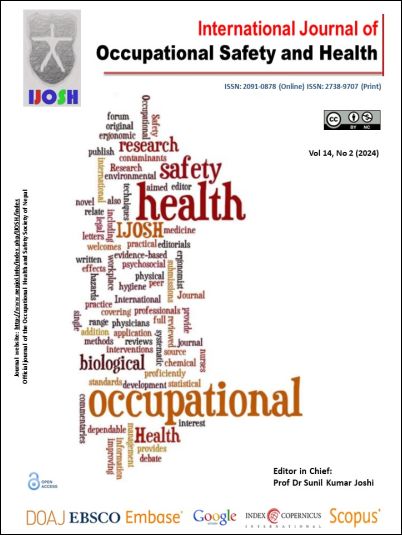Application of Machine Learning Modeling for the Upstream Oil and Gas Industry Injury Rate Prediction
DOI:
https://doi.org/10.3126/ijosh.v14i2.52668Keywords:
Machine learning, injury rates, continuous improvement, lean safety, Safety innovationAbstract
Introduction: Yearly, the International Labor Organization report indicates many workplace accident occurrences. The degree of the happenings depends on the workplace environment setting and the incident regulatory measures implemented. By the nature of its work environment, the oil and gas upstream sector is susceptible to high incident rates. In the current fierce business competition and practices, improving productivity, quality, and other processes, such as Safety, is vital. Implementing well-designed safety procedures is the key to managing and reducing the risk level of workplace incidents.
Methods: Recently, the application of Machine learning (ML) modeling for accident/injury prediction has been reported in the construction, mining, transport, and health sectors. Likewise, the objective of this paper was to implement three machine-learning-based models to predict injury rates in a drilling operation. The petroleum safety authority of Norway provided the datasets. First, the dataset was pre-processed, and then the selected features and target dataset were used for the modeling. Finally, the model prediction and performance accuracy analysis were performed.
Results: Results showed that multivariable regression (MVR), Random Forest (RF), and Artificial Neural Network (ANN) machine learning algorithms-based models predict the test data with R2 values of 0.9576, 0.793, and 0.97036, respectively.
Conclusion: As the common saying goes, 'prevention is better than cure.' For this, implementing methods such as improved work processes and Health, Safety, and Environment (HSE) mitigation procedures, workplace injuries, and accidents allow for reducing the risk level of workplace injuries. The application of integrated machine learning tools, along with carefully built-in workplace accident database implementation, will provide early detection and possible remedial precautions that can be taken to prevent workplace injuries/accidents/fatalities. However, extensive research and development are required to deploy the method in real life. Combining Machine Learning modeling and carefully designed safety measures is vital for successful and robust predictive tools.
Downloads
Downloads
Published
How to Cite
Issue
Section
License
Copyright (c) 2024 The Author(s)

This work is licensed under a Creative Commons Attribution-NonCommercial 4.0 International License.
This license enables reusers to distribute, remix, adapt, and build upon the material in any medium or format for noncommercial purposes only, and only so long as attribution is given to the creator.





